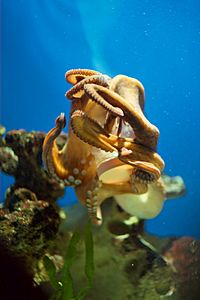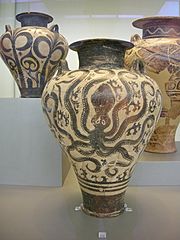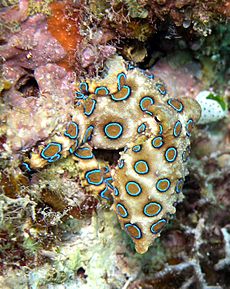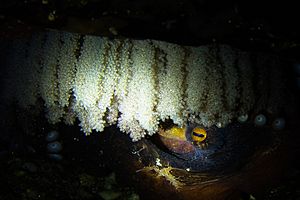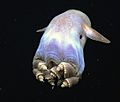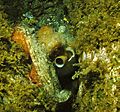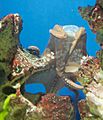Octopus facts for kids
Quick facts for kids Octopus |
|
|---|---|
 |
|
| Octopus vulgaris, the common octopus | |
| Scientific classification | |
| Kingdom: | |
| Phylum: | |
| Class: | |
| Subclass: | |
| Superorder: | |
| Order: | |
| Suborder: |
Incirrina
|
| Genus: |
Octopus
|
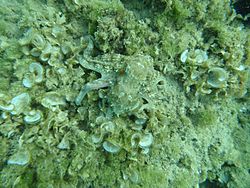
The Octopus is a type of cephalopod mollusc. It belongs to the group called Octopoda. Octopuses are well-known for their two eyes and eight arms, which are covered in suckers. They have a strong, hard beak, like a parrot's, located in the middle of their arms.
Octopuses do not have bones inside their bodies or a shell outside. This means they can squeeze into very small spaces, like cracks in rocks or corals. They are very smart hunters and love to eat crabs.
You can find octopuses in many parts of the ocean, especially around coral reefs. To stay safe from other animals, they can hide, swim away fast, squirt out black ink, or change their skin color to blend in. Most octopuses do not live for very long.
When an octopus swims, its eight arms trail behind it. Almost all octopuses have venom, but only the small blue-ringed octopus is known to be dangerous to humans.
There are about 300 different kinds of octopuses, and more than 100 of them are in the Octopus group. Octopuses make up more than a third of all living cephalopods. When people say "octopus," they usually mean those in the Octopus group. The word "octopod" refers to all members of the Octopoda group.
Most octopus species are not in danger of disappearing, according to the International Union for Conservation of Nature.
Contents
Octopus Body Structure
Unlike many other cephalopods, most octopuses have a soft body with no bones inside. They do not have a hard outer shell like the nautilus, which is another kind of cephalopod.
Their only hard part is their beak, which looks a lot like a parrot's beak. Because they have no bones, an octopus can easily squeeze through very narrow openings. For example, an octopus can fit through a hole as small as its eye!
How Smart Are Octopuses?
Octopuses are very intelligent animals. They are probably smarter than any other animal without a backbone. Scientists are still learning how much they can learn and remember. Experiments show that octopuses have both short-term and long-term memory. However, they do not live very long, which limits how much they can learn.
Some octopuses, like the Mimic octopus, can move their arms in ways that copy other sea creatures. This helps them hide or trick predators.
In labs, octopuses have been taught to tell the difference between different shapes and patterns. They have even been seen doing things that look like play. For example, they might drop bottles or toys into a water current in their tanks and then catch them again. Octopuses are also known to escape from their tanks, sometimes even breaking into other tanks to find food!
The biggest octopus species is the Giant octopus, Enteroctopus. These are truly huge! Adult males can weigh about 50 pounds, and females about 33 pounds. Their arms can stretch about eight feet wide. They have even climbed onto fishing boats and opened storage areas to get and eat crabs.
Octopuses are the only animals without a backbone that have been clearly shown to use tools. At least four Veined Octopuses (Amphioctopus marginatus) have been seen picking up old coconut shells. They then put the shells back together to use as a shelter.
What Do Octopuses Eat?
Right: An Ancient Greek vase (530–520 BC) showing a soldier with an octopus on his shield.
Octopuses are active and smart predators. They have good eyesight and big brains. They mostly eat crabs and some fish. Some types of octopuses even eat other octopuses!
Octopus Defenses
Octopuses have many ways to protect themselves. They can actively change their skin color and patterns to blend in with their surroundings, which is called camouflage. They can also copy other animals. Their nervous system controls these amazing changes. Most octopuses can squirt out clouds of black ink to help them escape from danger. Some can even drop an arm if they are in extreme danger. The arm wiggles and distracts the attacker, giving the octopus time to get away.
Octopus Eyes
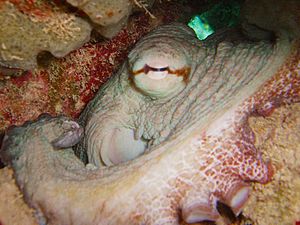
Octopus eyes are very complex. Unlike human eyes, they do not have a blind spot. A blind spot is a small area in our eyes that cannot see light. Our brain usually "fills in" this missing part, so we do not notice it. But an octopus does not have this problem at all!
The lens in an octopus's eye can move back and forth to focus. This is similar to how a camera focuses. When a camera takes a picture, its lens moves until the image is perfectly clear.
Octopus Colors and Feelings
Some octopuses use their special color cells, called chromatophores, for more than just camouflage. They can also use colors to show how they are feeling. For example, when an octopus is relaxed, it might be a dull, grayish-brown or orange color. If it gets angry, it can turn bright red. If it feels scared, it might turn white.
Octopus Reproduction and Life Cycle
When octopuses reproduce, the male uses a special arm to put sperm packets into the female's mantle cavity. After mating, male octopuses usually die within a few months. In some species, the female octopus can store the sperm inside her for weeks until her eggs are ready.
After the eggs are fertilized, the female lays a huge number of eggs, sometimes around 200,000 (though this number changes a lot between different species). The female octopus takes great care of her eggs. She guards them from predators and gently blows water over them to make sure they get enough oxygen. During the month or so she spends caring for her eggs, the female does not hunt for food. She might even eat parts of her own arms to survive.
Around the time the eggs hatch, the mother octopus leaves her hiding spot. She is usually very weak and cannot defend herself from predators like cod. She often dies soon after. The tiny baby octopuses, called paralarvae, float in clouds of plankton for a while. They eat plankton until they are ready to swim down to the ocean bottom, where their own life cycle begins.
All octopuses that scientists have studied have a fairly short life expectancy. Some species live for only about six months. Larger species, like the North Pacific giant octopus, can live for up to five years if conditions are good.
Reproduction is a main reason for their short lives. Males die a few months after mating, and females die soon after their eggs hatch. Even though females do not eat for about a month while caring for their eggs, they do not seem to die from starvation. Scientists are still trying to understand why octopuses have such short lives.
Deep-Sea Octopus Mothers
Off the coast of California, marine biologists watched a female octopus guarding her eggs for over four years! Her eggs took a very long time to develop because the water was extremely cold, about 1.4 kilometers deep. Scientists knew it was the same octopus because she had a special scar. They used a remote-controlled diving vehicle with cameras, lights, and robotic arms to observe her.
Images for kids
-
A giant Pacific octopus at Echizen Matsushima Aquarium, Japan.
-
A diagram of an octopus from the side, showing its gills, funnel, eye, eyespot, web, arms, and suckers.
-
A Veined octopus eating a crab.
-
Movements of the finned species Cirroteuthis muelleri.
-
Octopuses evolved from creatures like the Muensterella scutellaris (a fossil shown here) during the Jurassic period.
-
A Minoan clay vase from about 1500 BC, decorated with an octopus.
-
A drawing from 1801 by malacologist Pierre Denys de Montfort, showing an imagined colossal octopus attacking a ship.
-
A flexible biomimetic 'Octopus' robotics arm from The BioRobotics Institute in Pisa, 2011.
See also
 In Spanish: Pulpos para niños
In Spanish: Pulpos para niños


